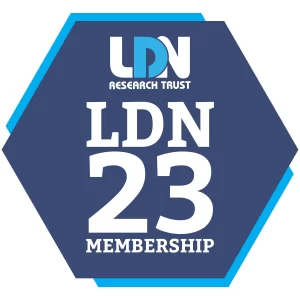What is Naltrexone?
Naltrexone is a medication that was originally approved as the treatment for opioid addiction and alcoholism. During the 1980’s a Harvard MD discovered that at around 4.5mg naltrexone could bind to the immune cells. Since then, ongoing research regarding Low-dose naltrexone (LDN) has found benefits for patients with chronic pain, autoimmune diseases, and, fibromyalgia. LDN has demonstrated it is both safe and effective in small scale studies for fibromyalgia.
How Low-Dose Naltrexone Works:
Naltrexone is a mu-opioid antagonist and has two similar, but different structures. The first one is known as L-naltrexone and the second is D- naltrexone. L-naltrexone binds to the opioid receptors causing an increase in endorphin release. The Dextro-naltrexone binds to the immune cells including TLR4 and preventing the release of NF-KB which reduces inflammation.
In a study completed at Stanford University, 28 women with fibromyalgia took one pill a day for 16 weeks. During that time, each woman took the LDN (4.5 mg) for 12 weeks and a sugar pill (placebo) for 4 weeks. The study was double-blind, meaning that neither the women participating in the study nor the healthcare team knew which pill they were taking at any time. Each woman was given a handheld computer to record their pain, fatigue, and other symptoms on a daily basis, and they continued to record their symptoms for 4 weeks after they stopped.
Participants experienced a significantly greater reduction in their pain scores while they were taking the LDN as compared with while placebo. They also reported improved general satisfaction with life and improved mood while taking LDN. However, there was no improvement in fatigue or sleep. All participants tolerated the LDN, with few side effects.
When to Use LDN:
We recommend using LDN when other anti inflammatory medications haven’t provided chronic pain relief from fibromyalgia. Some time over the counter pain relievers cause side effects and liver issues. So people with chronic pain or fibromyalgia might want to talk to prescribers for LDN as an alternative. LDN also works well as it block the pain receptors preventing opioid addiction.
LDN also helps for mental health issues like PTSD and mood disorders.
Low-Dose Naltrexone Side Effects:
Women in the study experienced side effects such as sleep disturbances, mild headache, mild agitation, and upset stomach.
Uncommon Side Effects included Flu-like symptoms, rash, high temperature, and dizziness.
LDN should not be taken by patients who ae also taking opioids such as morphine, oxycodone, or hydrocodone. It is possible that even a low dose of naltrexone could induce withdrawal symptoms.
LDN is not commercially available but can be personalized into various dosage forms by prescription. We can make it into various strengths and dosage forms including:
- Liquids
- Capsules
- Sublingual Drops
- Topical Creams
The most commonly prescribed strengths of naltrexone for fibromyalgia include 1.5mg, 3 mg, and 4.5 mg
When naltrexone is combined with b6, melatonin, or magnesium, there is typically a reduction in sleep issues.
Another great option is to add functional supplements to help with the free radical damage from your body not generating enough energy like alpha lipoic acid, n-acetyl cysteine, vitamin c, and acetyl-l-carnitine. To learn more about low-dose naltrexone click here.
To learn more about ldn visit www.ldncompounding.com
We are also a proud member of the LDN Research Trust. The LDN Research Trust has been collecting information on LDN for years. Check out their information here.

